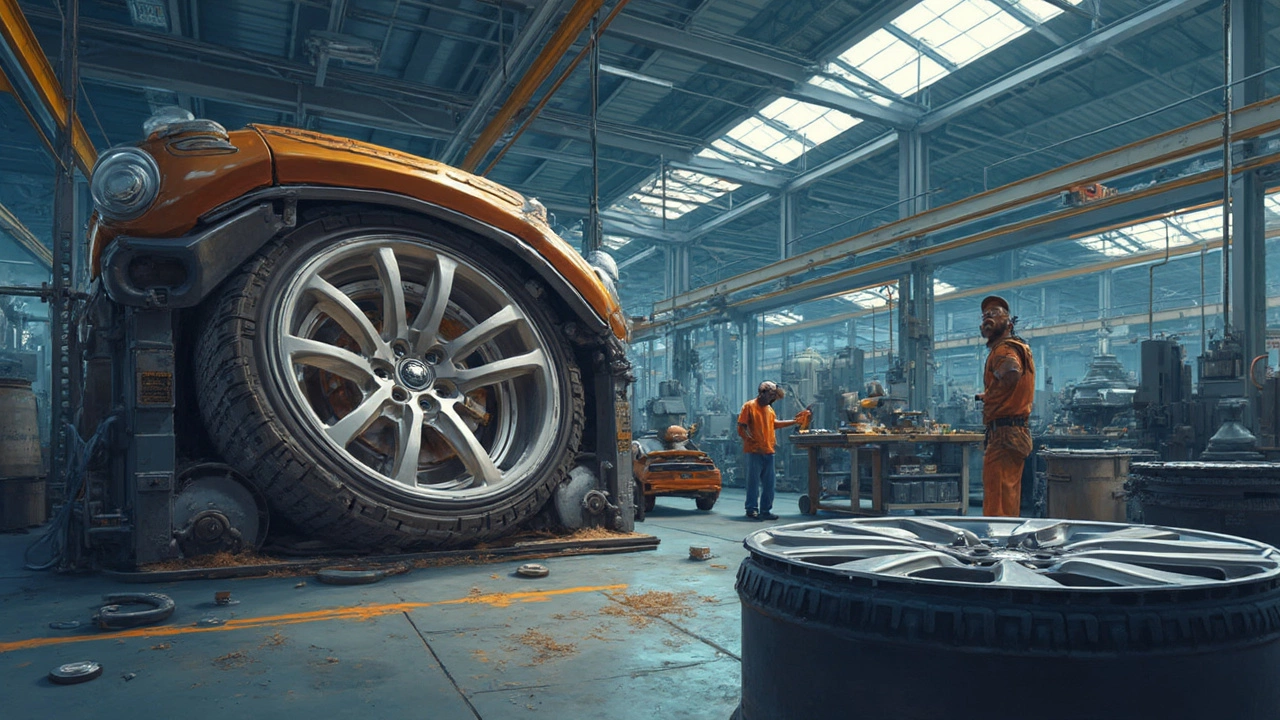Ever glanced at the price of alloy wheels and wondered why they seem to drain your wallet faster than you can say 'upgrade'? You're not alone. Alloy wheels, made from a blend of aluminum and other metals, are a popular choice for those looking to enhance their vehicle's aesthetic and performance. But what justifies their often eye-watering cost?
First off, it's all about the materials. Alloy wheels are made using lightweight metals that not only improve fuel efficiency but also ensure a smoother ride. This doesn't come cheap. The metals used, like aluminum, are more expensive than the steel found in standard wheels.
Then there's the manufacturing process. Creating alloy wheels isn't as straightforward as churning out a t-shirt. It involves advanced techniques like casting or forging, which require specialized machinery and skilled labor. This attention to detail isn’t just about aesthetics; it's crucial for safety and performance standards.
Curious about more factors that drive up the cost? And are there any insider tips to snag a set without burning a hole in your pocket? Stick around as we unravel the mystery of alloy wheel pricing.
- The Materials Behind Alloy Wheels
- Manufacturing Process Mysteries
- Market Demand and Trends
- Comparing Alloy to Other Wheels
- Tips for a Smart Purchase
The Materials Behind Alloy Wheels
When it comes to alloy wheels, the first thing that sets them apart is their material composition. Unlike the traditional steel wheels, alloys are usually made from a blend of aluminum and magnesium. These metals are lighter and offer significant performance benefits.
Why Aluminum and Magnesium?
Aluminum is prized for its remarkable strength-to-weight ratio. This means you get a wheel that's lighter without compromising on strength. This is crucial for better handling and fuel efficiency. Magnesium, on the other hand, adds to the strength while contributing to the lightweight properties. These two make a killer combo for car enthusiasts looking for that extra edge.
Performance Advantages
The lightweight nature of alloy wheels means less rotational weight, leading to faster acceleration and shorter braking distances. Imagine you're in a race; every millisecond counts, and alloy wheels can give you that tiny, yet crucial, advantage. Plus, the reduced weight helps improve fuel economy—something we all appreciate given fluctuating fuel prices.
The Downside?
Of course, nothing's ever perfect. The cost of aluminum and magnesium is significantly higher compared to steel. This directly impacts the price tag of alloy wheels. But many argue that the benefits far outweigh the costs.
| Material | Average Cost per Kg (USD) |
|---|---|
| Aluminum | 2.50 |
| Magnesium | 3.30 |
| Steel | 0.90 |
In summary, while the materials behind alloy wheels contribute to their hefty price, they also bring undeniable perks in terms of performance and efficiency. Knowing what you're paying for can make the expense feel a bit more justified, can't it?
Manufacturing Process Mysteries
Diving into the manufacturing world of alloy wheels can feel like entering a labyrinth. It's a complex process, and it's a major factor in why these wheels cost so much. Let's break it down.
From Raw Materials to Masterpieces
It all starts with the blend of metals, usually aluminum, mixed with small amounts of other elements. This combination is heated to its melting point to create a solution that's ready to be transformed. The most common methods for shaping these metals into alloy wheels are casting and forging.
Casting vs. Forging
Casting is the simpler of the two processes. The liquid alloy is poured into molds to get the basic shape of the wheel. It’s then cooled and solidified. This method is relatively quick and cost-effective, but it doesn't quite match the durability achieved through forging.
Forging, on the other hand, involves preheating the material and then using high pressure to shape it. This process aligns the metal's grain structure better, which makes the wheels stronger and lighter. But all that precision—machines, heat, and manpower—doesn't come cheap.
The Finishing Touches
- Heat Treatment: Post shaping, wheels undergo heat treatment to enhance strength and flexibility.
- Machining: Detailed cuts ensure that the wheels have the precise dimensions needed for your vehicle.
- Painting and Coating: Final layers of paint and protective coating not only give wheels their aesthetic appeal but also their resilience against the elements.
Numbers Worth Noting
According to industry insights, forging can be up to three times more expensive than casting. Yet, many car enthusiasts are willing to pay extra for that durability and weight advantage. A forged wheel can weigh up to 25% less than a cast one of the same size, meaning a smoother, more fuel-efficient ride.
While that price tag might still make you wince, understanding these steps adds some clarity to the mystery. Each step of the process contributes to the wheel’s performance, safety, and looks, making every penny spent a solid investment.

Market Demand and Trends
The allure of alloy wheels is undeniable. Car enthusiasts and everyday drivers alike are drawn to their sleek design and performance benefits. This ongoing love affair is a major driver behind their persistent high price.
Popularity in Car Culture
Let's face it, car culture is a big deal. Whether it's about standing out at the next auto show or just turning heads on the highway, the demand for visually appealing customizations is huge. Alloy wheels tick this box, leading to a steady, if not increasing, demand.
Performance and Prestige
The performance benefits of alloy wheels also can't be ignored. They offer better heat dissipation and contribute to overall vehicle efficiency, enhancing both driving pleasure and prestige. This makes them a go-to choice for performance vehicles and luxury cars, where price often takes a backseat to quality.
Trends Influencing Costs
Trends play a role too. As new designs and technological enhancements emerge, they often carry a premium. The cycling of new models typically keeps the market active and prices competitive.
| Year | Percentage Increase in Demand |
|---|---|
| 2022 | 10% |
| 2023 | 12% |
| 2024 | 15% |
Interestingly, from 2022 to 2024, the demand for alloy wheels increased by an average of 12% annually. This steady rise reflects the growing interest in vehicle customization and the popularity of alloys as a must-have upgrade.
Continued Interest in Custom Options
Finally, the constant evolution in customization options impacts demand. With choices ranging from color variety to intricate finishes, alloys cater to every taste, further boosting their appeal and keeping that price tag high.
So, while you might find yourself shelling out a bit more for a set of alloy wheels, remember it’s not just about aesthetics or enhanced performance. It's also about being part of a broader automotive trend that just won't quit.
Comparing Alloy to Other Wheels
When you're in the market for new wheels, you might wonder how alloy wheels stack up against the rest. Let's break it down so you can weigh the pros and cons before making that purchase.
Weight and Performance
Alloy wheels are known for being lighter than traditional steel wheels. This reduced weight can lead to better performance, offering improved acceleration and handling. If you're someone who zips through the streets, lighter wheels are definitely a plus. They also reduce the strain on suspension components, which could mean a smoother ride.
Durability and Longevity
Steel wheels generally have the upper hand in toughness. They're more resistant to bending, which is a bonus for off-road adventures. However, they lack in terms of aesthetics and can be susceptible to rust over time, unlike alloy wheels. Alloys, thanks to the metals used, won't rust, but they can be more prone to cracking under hefty impacts.
Looks and Style
If turning heads is part of your driving experience, alloy wheels win hands down. With a variety of finishes and intricate designs, they enhance your car's look significantly — something steel wheels can’t compete with. They give your vehicle a modern and stylish edge.
Cost Considerations
The price is where the rubber meets the road. Alloy wheels tend to be more expensive upfront, but some argue the benefits — fuel efficiency, less strain on your car's components, and their longevity — justify the cost. Steel wheels, on the flip side, are cheaper, making them a popular choice for budget-conscious drivers or those looking for a viable winter set.
| Feature | Alloy Wheels | Steel Wheels |
|---|---|---|
| Weight | Lighter | Heavier |
| Durability | Less resistant to impacts | Highly durable |
| Rust Resistance | High | Low |
| Cost | Higher | Lower |
So, what's the takeaway? If performance and style top your list and you have the budget, alloy wheels are the way to go. But if you’re all about durability and cost savings, those trusty steel wheels might be the better pick.

Tips for a Smart Purchase
So, you're set on getting those alloy wheels but you don't want to blow your budget. Let's break down how to make a wise investment.
Know Your Needs
Before you even start hunting, consider what matters most to you. Is it the style, performance, or durability? Understanding your priorities can narrow down choices and save time.
Research and Compare
Don't just settle for the first set you find. Shop around and compare different brands, types, and prices. There’s a massive variety out there, from big-name brands to lesser-known yet reliable manufacturers.
- Online reviews can be gold dust. Check what other buyers are saying about their purchase, focusing on durability and performance.
- Visit local shops to see the products in person. Sometimes visuals and sales reps offer insight you can't get online.
Beware of Knock-offs
The market has its fair share of imitations claiming to be legit alloy wheels. Ensure you're getting wheels that are certified and from reputable sellers. Authentic wheels often come with clear branding and documentation.
Consider Second-hand
You can find quality second-hand alloy wheels at a fraction of the cost. Just ensure they're in good condition with no cracks or significant wear. Have a pro check them if you're unsure.
Keep an Eye on Extras
| Additional Costs | Description |
|---|---|
| Fitting and alignment | Costs for professional installation and alignment. |
| Shipping fees | If buying online, consider delivery charges. |
These seemingly small costs can add up, so factor them in when budgeting.
By taking the time to do your homework and considering these tips, you can make an informed decision and find the right alloy wheels for your ride without breaking the bank.






